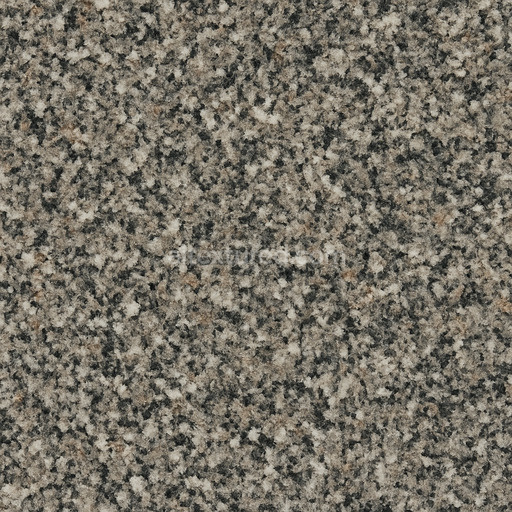The coarse granite texture seamless high resolution up to 8ktexture is an expertly crafted AI-generated stone texture designed to replicate the natural complexity and rugged beauty of coarse granite surfaces. Granite, a durable igneous rock primarily composed of quartz, feldspar, and mica minerals, forms the authentic base substrate of this texture. The grain orientation and visible mineral aggregates are faithfully represented through a detailed micro-structure, capturing the speckled appearance and muted earth tones typical of granite. Subtle porosity and weathering effects are integrated to provide a realistic, rough matte finish, evoking the tactile quality of unpolished stone. These natural variations in color and texture are reflected across the PBR channels: the BaseColor/Albedo channel displays a balanced palette of grays and browns, Normal maps emphasize the uneven grain and mineral relief, while Roughness maps define the matte, lightly weathered surface. Metallic values remain near zero, consistent with granite’s non-metallic nature, and Ambient Occlusion enhances the depth of crevices and mineral boundaries. The Height/Displacement channel further accentuates surface undulations and the granular structure, adding dimensional realism to 3D models and renders.
This tileable coarse granite texture seamless high resolution up to 8k excels in scenarios requiring seamless coverage over large surfaces without visible repetition or seams, making it ideal for architectural visualization, game environments, product mockups, and interior staging. Its ultra-high resolution—up to 8K detail—ensures crisp visuals that maintain clarity even under close inspection in 3D preview and real-time rendering workflows. Fully compatible with popular platforms such as Blender, Unreal Engine, and Unity, the texture is provided in versatile formats like PNG and WEBP to maximize performance and ease of integration. The AI-driven generation process guarantees structural consistency and micro-detail fidelity, resulting in a production-ready stone texture that requires minimal adjustment while delivering maximum realism and visual appeal.
For optimal use, maintaining consistent UV scale across assets is recommended to prevent stretching and distortion of the stone’s natural grain pattern. Adjusting roughness values allows customization of the surface finish, enabling simulation of conditions ranging from freshly quarried rough granite to weathered, matte stone. Utilizing the Height/Displacement channel effectively enhances depth perception and tactile realism, particularly in close-up renders or interactive 3D environments. This seamless coarse granite texture seamless high resolution up to 8ktexture streamlines workflows by providing a reliable, visually compelling material foundation that integrates smoothly into diverse stone texture libraries and PBR setups, elevating the authenticity and detail of any digital project.
How to Use These Seamless PBR Textures in Blender
This guide shows how to connect a full PBR texture set to Principled BSDF in Blender (Cycles or Eevee). Works with any of our seamless textures free download, including PBR PNG materials for Blender / Unreal / Unity.
What’s inside the download
*_albedo.png — Base Color (sRGB)*_normal.png — Normal map (Non-Color)*_roughness.png — Roughness (Non-Color)*_metallic.png — Metallic (Non-Color)*_ao.png — Ambient Occlusion (Non-Color)*_height.png — Height / Displacement (Non-Color)*_ORM.png — Packed map (R=AO, G=Roughness, B=Metallic, Non-Color)

Quick start (Node Wrangler, 30 seconds)
- Enable the addon: Edit → Preferences → Add-ons → Node Wrangler.
- Create a material and select the Principled BSDF node.
- Press Ctrl + Shift + T and select the maps
albedo, normal, roughness, metallic (skip height and ORM for now) → Open.
The addon wires Base Color, Normal (with a Normal Map node), Roughness, and Metallic automatically.
- Add AO and Height using the “Manual wiring” steps below (5 and 6).
Manual wiring (full control)
- Create a material (Material Properties → New) and open the Shader Editor.
- Add an Image Texture node for each map. Set Color Space:
- Albedo → sRGB
- AO, Roughness, Metallic, Normal, Height, ORM → Non-Color
- Connect to Principled BSDF:
albedo → Base Colorroughness → Roughnessmetallic → Metallic (for wood this often stays near 0)normal → Normal Map node (Type: Tangent Space) → Normal of Principled.
If details look “inverted”, enable Invert Y on the Normal Map node.
- Ambient Occlusion (AO):
- Add a MixRGB (or Mix Color) node in mode Multiply.
- Input A =
albedo, Input B = ao, Factor = 1.0.
- Output of Mix → Base Color of Principled (replaces the direct albedo connection).
- Height / Displacement:
Cycles — true displacement
- Material Properties → Settings → Displacement: Displacement and Bump.
- Add a Displacement node: connect
height → Height, set Midlevel = 0.5, Scale = 0.02–0.08 (tune to taste).
- Output of Displacement → Material Output → Displacement.
- Add geometry density (e.g., Subdivision Surface) so displacement has polygons to work with.
Eevee (or lightweight Cycles) — bump only
- Add a Bump node:
height → Height.
- Set Strength = 0.2–0.5, Distance = 0.05–0.1, and connect Normal output to Principled’s Normal.
Using the packed ORM texture (optional)
Instead of separate AO/Roughness/Metallic maps you can use the single *_ORM.png:
- Add one Image Texture (Non-Color) → Separate RGB (or Separate Color).
- R (red) → AO (use it in the Multiply node with albedo as above).
- G (green) → Roughness of Principled.
- B (blue) → Metallic of Principled.
UVs & seamless tiling
- These textures are seamless. If your mesh has no UVs, go to UV Editing → Smart UV Project.
- For scale/repeat, add Texture Coordinate (UV) → Mapping and plug it into all texture nodes.
Increase Mapping → Scale (e.g., 2/2/2) to tile more densely.
Recommended starter values
- Normal Map Strength: 0.5–1.0
- Bump Strength: ~0.3
- Displacement Scale (Cycles): ~0.03
Common pitfalls
- Wrong Color Space (normals/roughness/etc. must be Non-Color).
- “Inverted” details → enable Invert Y on the Normal Map node.
- Over-strong relief → lower Displacement Scale or Bump Strength.
Example: Download Wood Textures and instantly apply parquet or rustic planks inside Blender for architectural visualization.
To add the downloaded texture, go to Add — Texture — Image Texture.

Add a node and click the Open button.

Select the required texture on your hard drive and connect Color to Base Color.


